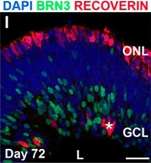Scientists produce eye structures from human blood-derived stem cells

(Medical Xpress) -- For the first time, scientists at the University of Wisconsin-Madison have made early retina structures containing proliferating neuroretinal progenitor cells using induced pluripotent stem (iPS) cells derived from human blood.
And in another advance, the retina structures showed the capacity to form layers of cells - as the retina does in normal human development - and these cells possessed the machinery that could allow them to communicate information. (Light-sensitive photoreceptor cells in the retina along the back wall of the eye produce impulses that are ultimately transmitted through the optic nerve and then to the brain, allowing you to see.)
Put together, these findings suggest that it is possible to assemble human retinal cells into more complex retinal tissues, all starting from a routine patient blood sample.
Many applications of laboratory-built human retinal tissues can be envisioned, including using them to test drugs and study degenerative diseases of the retina such as retinitis pigmentosa, a prominent cause of blindness in children and young adults. One day, it may also be possible replace multiple layers of the retina in order to help patients with more widespread retinal damage.
"We don't know how far this technology will take us, but the fact that we are able to grow a rudimentary retina structure from a patient's blood cells is encouraging, not only because it confirms our earlier work using human skin cells, but also because blood as a starting source is convenient to obtain," says Dr. David Gamm, pediatric ophthalmologist and senior author of the study. "This is a solid step forward."
In 2011, the Gamm lab at the Waisman Center created structures from the most primitive stage of retinal development using embryonic stem cells and stem cells derived from human skin. While those structures generated the major types of retinal cells, including photoreceptors, they lacked the organization found in more mature retina.
This time, the team, led by Gamm, assistant professor of ophthalmology and visual sciences in the UW School of Medicine and Public Health, and postdoctoral researcher and lead author Dr. Joseph Phillips, used their method to grow retina-like tissue from iPS cells derived from human blood gathered via standard blood draw techniques.
In their study, about 16 percent of the initial retinal structures developed distinct layers. The outermost layer primarily contained photoreceptors, whereas the middle and inner layers harbored intermediary retinal neurons and ganglion cells, respectively. This particular arrangement of cells is reminiscent of what is found in the back of the eye.
Further, work by Dr. Phillips showed that these retinal cells were capable of making synapses, a prerequisite for them to communicate with one another.
The iPS cells used in the study were generated through collaboration with Cellular Dynamics International (CDI) of Madison, Wisconsin, which pioneered the technique to convert blood cells into iPS cells. CDI scientists extracted a type of blood cell called a T-lymphocyte from the donor sample, and reprogrammed the cells into iPS cells. Cellular Dynamics International was founded by UW-Madison stem cell pioneer Dr. James Thomson.
"We were fortunate that CDI shared an interest in our work. Combining our lab's expertise with that of CDI was critical to the success of this study," added Gamm.
More information: The results were published in the March 12, 2012 online issue of Investigative Ophthalmology & Visual Science, the journal of the Association for Research in Vision and Ophthalmology.


















